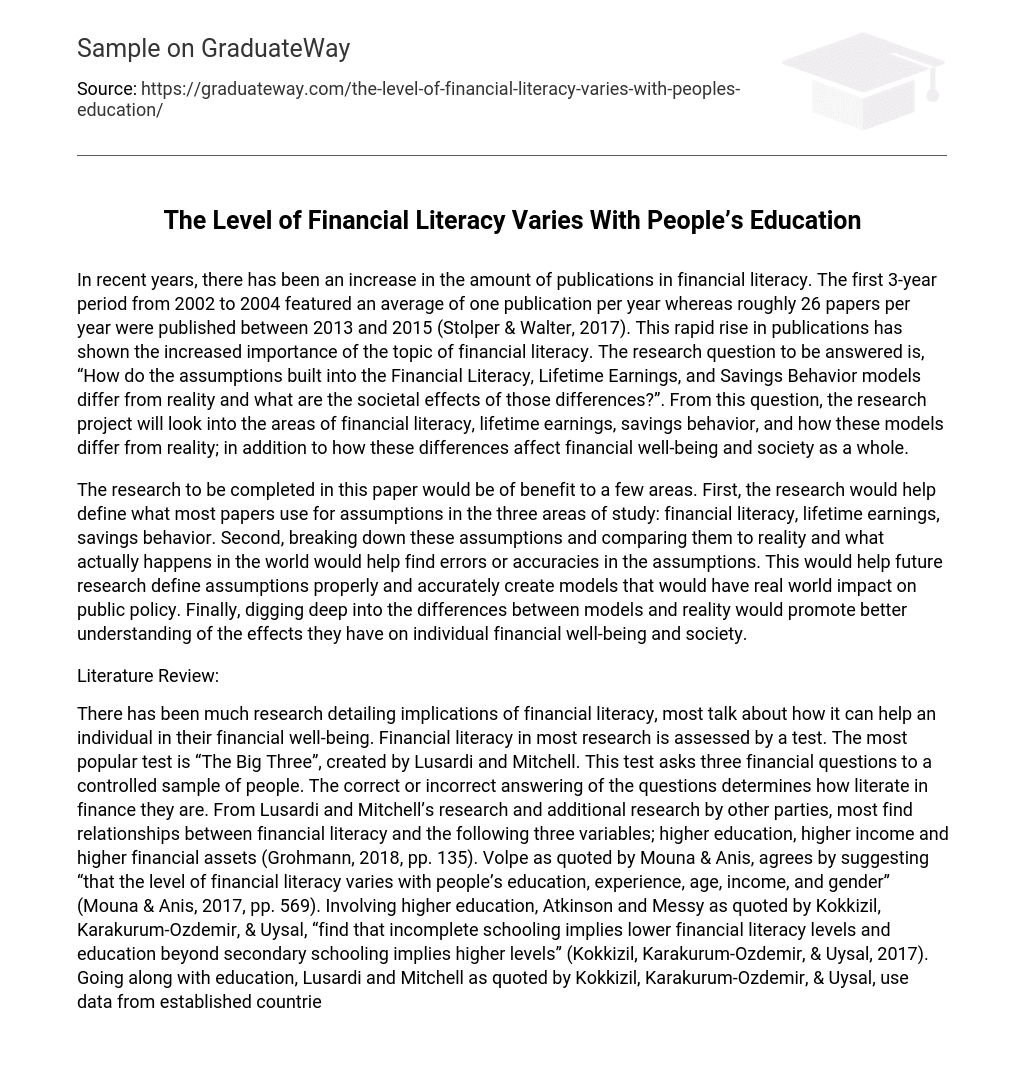In recent years, there has been an increase in the amount of publications in financial literacy. The first 3-year period from 2002 to 2004 featured an average of one publication per year whereas roughly 26 papers per year were published between 2013 and 2015 (Stolper & Walter, 2017). This rapid rise in publications has shown the increased importance of the topic of financial literacy. The research question to be answered is, “How do the assumptions built into the Financial Literacy, Lifetime Earnings, and Savings Behavior models differ from reality and what are the societal effects of those differences?”. From this question, the research project will look into the areas of financial literacy, lifetime earnings, savings behavior, and how these models differ from reality; in addition to how these differences affect financial well-being and society as a whole.
The research to be completed in this paper would be of benefit to a few areas. First, the research would help define what most papers use for assumptions in the three areas of study: financial literacy, lifetime earnings, savings behavior. Second, breaking down these assumptions and comparing them to reality and what actually happens in the world would help find errors or accuracies in the assumptions. This would help future research define assumptions properly and accurately create models that would have real world impact on public policy. Finally, digging deep into the differences between models and reality would promote better understanding of the effects they have on individual financial well-being and society.
Literature Review:
There has been much research detailing implications of financial literacy, most talk about how it can help an individual in their financial well-being. Financial literacy in most research is assessed by a test. The most popular test is “The Big Three”, created by Lusardi and Mitchell. This test asks three financial questions to a controlled sample of people. The correct or incorrect answering of the questions determines how literate in finance they are. From Lusardi and Mitchell’s research and additional research by other parties, most find relationships between financial literacy and the following three variables; higher education, higher income and higher financial assets (Grohmann, 2018, pp. 135). Volpe as quoted by Mouna & Anis, agrees by suggesting “that the level of financial literacy varies with people’s education, experience, age, income, and gender” (Mouna & Anis, 2017, pp. 569). Involving higher education, Atkinson and Messy as quoted by Kokkizil, Karakurum-Ozdemir, & Uysal, “find that incomplete schooling implies lower financial literacy levels and education beyond secondary schooling implies higher levels” (Kokkizil, Karakurum-Ozdemir, & Uysal, 2017). Going along with education, Lusardi and Mitchell as quoted by Kokkizil, Karakurum-Ozdemir, & Uysal, use data from established countries like Germany, Norway, Japan, U.S., etc. and they find that more education increases financial literacy levels (Kokkizil, Karakurum-Ozdemir, & Uysal, 2017). Moving away from education research looked into higher income levels. In the Kokkizil, Karakurum-Ozdemir, & Uysal study, they observed financial literacy levels in Central and South America (Mexico, Lebanon, Uruguay, Colombia and Turkey), and they found that financial literacy rises with income. Kokkizil, Karakurum-Ozdemir, & Uysal also add that, because of the findings that financial literacy rises with income, there could be a correlation between income and quality of education or access to financial information. Thus inferring that higher incomes give access to better quality education and financial information which would allow individuals to be more financially literate. Gustman, Steinmeier, & Tabatabai concur based on their findings that, “pension knowledge and social security knowledge are related to pension wealth” (Gustman, Steinmeier, & Tabatabai, 2010). They believe that the correlation can be explained from wealth to knowledge not the other way around. Kokkizil, Karakurum-Ozdemir, & Uysal also suggest that, individuals with higher income have more opportunity to make financial decisions which pushes them to acquire more knowledge so they invest more money into financial information (Kokkizil, Karakurum-Ozdemir, & Uysal, 2017).
On top of the survey research, some studies have looked into retirement participation on how it could be related to savings behavior. As economies grow and more financial decisions are passed onto consumers, more studies have looked into how retirement participation has changed. As well as, are consumers taking advantage of the savings vehicles like a 401(k)? It has been found that as the complexity of retirement vehicles has grown over the years, it has made it either more confusing or intimidating for consumers to invest their money in the vehicles. A study in the U.S. found that large groups of employees either don’t participate or contribute less into their 401(k) (Stolper & Walter, 2017, pp. 583).
Van Rooij et al. as quoted by Mouna & Anis, talks about how individuals with low financial literacy are more prone to get advice from family and friends rather than inform themselves, which affects the way individuals choose to approach the market and causes them to exclude themselves from the market. This decision to not participate or contribute less to investments results in a large loss of employer matching contributions and investment growth over time. Stolper & Walter agree that market participation is lacking when it comes to less financially literate employee’s (Stolper & Walter, 2017). In addition, “the elderly, younger, less educated and lower income individuals had the worst financial literacy scores, which triggered a sign that these individuals were at the greatest risk of making financial mistakes” (Stolper & Walter, 2017, pp. 633). Like most of the studies into financial literacy, this study used the three question test to determine literacy and correlation to retirement savings participation. The largest assumption is that the questions asked represent that the individuals have a good understanding of finance.





